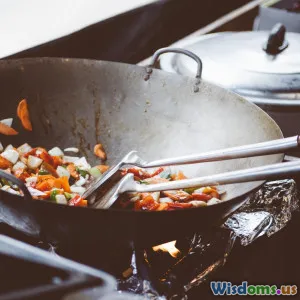
Mistakes to Avoid When Cooking for Large Crowds
8 min read Avoid common pitfalls when cooking for large crowds with smart strategies for planning, timing, and execution to ensure a smooth, delicious feast. (0 Reviews)
Mistakes to Avoid When Cooking for Large Crowds
Cooking for large crowds is a daunting yet rewarding endeavor. Whether you’re organizing a family reunion, corporate luncheon, wedding banquet, or community event, the stakes are high—not just in terms of feeding many mouths, but managing the process smoothly. Mistakes can turn a joyous celebration into a stressful scramble behind the scenes.
In this article, we'll dive into the key missteps people make when tackling large-scale cooking and how to avoid them. By mastering these insights, you’ll gain confidence and ensure your guests receive a delicious, timely meal without unnecessary headaches.
1. Lack of Proper Planning and Organization
Underestimating Quantity and Timing
One of the most common and costly errors is misjudging how much food to prepare and when. According to the USDA, over 30% of food in the United States spoils due to improper storage and planning. When cooking for a crowd, it’s crucial to:
- Calculate generous but realistic servings per person—factor in appetites and leftovers.
- Begin procurement and prep well in advance; some ingredients taste best fresh, but others benefit from marinating or prep days prior.
For example, a wedding caterer in New York found that by accurately predicting 5% higher consumption than initially estimated, they minimized last-minute shortages and guest complaints.
Organizing Workflow and Stations
Cooking multiple dishes simultaneously can be chaotic without defined stations and workflows. Designate areas for chopping, cooking, plating, and cleaning. This reduces bottlenecks and streamlines the process. Commercial kitchens often use assembly lines or brigades of chefs for efficiency—a lesson any home or event cook can adopt.
2. Ignoring Ingredient Selection and Quality
Bulk Buying Pitfalls
While buying in bulk may seem cost-effective, it invites risks such as spoilage and lower quality items. Choose suppliers carefully and inspect perishables.
Skimping on Quality for Quantity
Ironically, the temptation to cut corners on quality to stretch budget often backfires. Memorable meals come from good ingredients, such as fresh produce and well-sourced proteins. As Alice Waters said, "When you plant lettuce, even if it doesn’t grow well, you don’t throw it out – you eat the most tender, delicate leaves."
Balancing quantity with quality requires savvy substitutions and prioritizations. Perhaps spend more on main course proteins, while using cost-effective, flavorful sides.
3. Neglecting Food Safety Regulations
Foodborne illness can ruin any event and cause serious health consequences. The CDC estimates 48 million Americans suffer from foodborne illnesses annually, many linked to improper handling.
Critical safety steps include:
- Maintaining proper refrigeration below 40°F.
- Cooking meats to recommended internal temperatures—e.g., poultry to 165°F.
- Avoiding cross-contamination; keep raw and cooked foods separate.
- Ensuring all handlers practice hygiene and illness policies.
For example, during a recent large community picnic, organizers mitigated salmonella risk by promoting hand sanitizer stations and holding foods above 140°F during serving.
4. Overcomplicating the Menu
Keeping the menu manageable is vital. Offering dozens of dishes can spread resources thin and slow down preparation. Choose recipes that can scale easily and leverage batch cooking techniques.
Additionally, pre-prepared components like homemade sauces or dressings can be made in advance, freeing up time and mental bandwidth on event day.
Pro tip: One successful caterer highlights that menus with three main dishes, two sides, and a dessert balance variety without overwhelming kitchen capacity.
5. Forgetting to Accommodate Dietary Restrictions
Diversity in dietary needs is increasingly common—gluten-free, vegetarian, vegan, allergies, and religious considerations.
Failing to address these can isolate guests and cause last-minute logistical challenges.
Effective strategies include:
- Soliciting dietary information ahead of time during RSVP.
- Designing inclusive dishes or clearly marking options.
- Preparing a few safe, neutral dishes that most can enjoy.
Statistically, surveys show that around 31% of individuals have some food allergy or intolerance, underscoring the importance of thoughtful planning.
6. Poor Timing and Serving Logistics
Inflexible Cooking Schedules
Trying to have all dishes ready simultaneously without buffer times leads to stress and uneven meal temperatures.
Use slow cookers, warming trays, or chafing dishes strategically. For example, braising meats early in the day complements active cooking later.
Underestimating Serving Capacity
Have a clear serving strategy—buffet versus plated service. Buffets require different arrangements to avoid bottlenecks and keep food safe.
Many events invest in experienced serving staff or volunteers dedicated solely to ensuring smooth guest flow.
7. Inadequate Staffing and Delegation
Expecting to manage everything alone is a common rookie mistake. Cooking for a large crowd often requires a team approach.
Benefits of delegation include:
- Improved efficiency
- Reduced burnout
- More professional execution
Ask friends, family, or hire help with clear role assignments: prep cook, server, dishwasher. Providing checklists and timelines ensures everyone stays aligned.
8. Poor Equipment and Space Management
Insufficient or inappropriate equipment can derail even the best menu.
Essential equipment considerations:
- Large-capacity pots, pans, and baking trays
- Adequate refrigeration and warming units
- Enough ovens/stovetops for simultaneous cooking
Space constraints must also be addressed by reconfiguring kitchen layout or renting portable cooking stations for outdoor events.
Case in point, a caterer shared how renting additional warming ovens allowed them to keep food hot and fresh without overloading kitchen appliances.
Conclusion
Cooking for large crowds is both an art and a science requiring foresight, organization, and sometimes a bit of creativity. Avoiding common mistakes—such as under-planning, ignoring food safety, overcomplicating menus, and inadequate staffing—dramatically increases the likelihood your event will be memorable for all the right reasons.
Remember, preparation is your best tool. Accurate portion calculations, ingredient management, safety vigilance, and clear delegation transform potential chaos into a harmonious feast.
As chef Julia Child famously said, "No one is born a great cook, one learns by doing." With these insights, you’re well equipped to learn, improve, and confidently cook for any big occasion.
Ready to take your large crowd cooking to the next level? Start by auditing your last cooking event, apply these principles step-by-step, and watch the stress melt away!
Rate the Post
User Reviews
Other posts in Food & Sustainability
Popular Posts














